What Are the Most Common Types of Outsourcing Models?
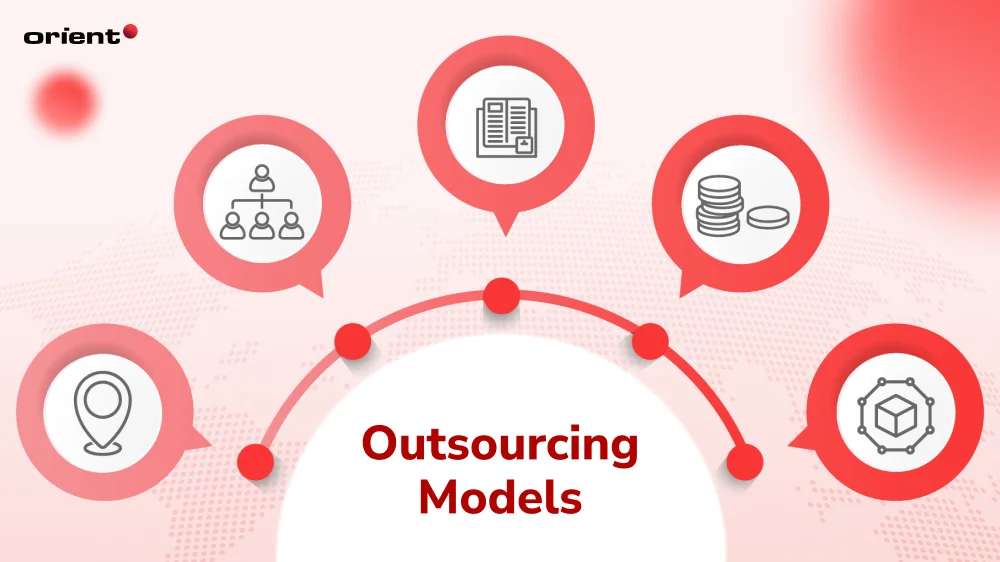
Content Map
More chaptersIn the tech industry, outsourcing has been growing and has become a standard business practice in recent years as companies look to reduce costs and improve efficiency at the same time. There are various types of outsourcing models that businesses can opt for, each with its own benefits and drawbacks. In this blog post, we’ll take a look at all the standard outsourcing models. Moreover, we will also go through the pros and cons of each model so you can decide which is right for your business.
These outsourcing models can be broken down into specific categories. Let’s have a look at the different models available in the outsourcing industry:
Location-based Outsourcing Models
In terms of geographical locations, there are different outsourcing models:
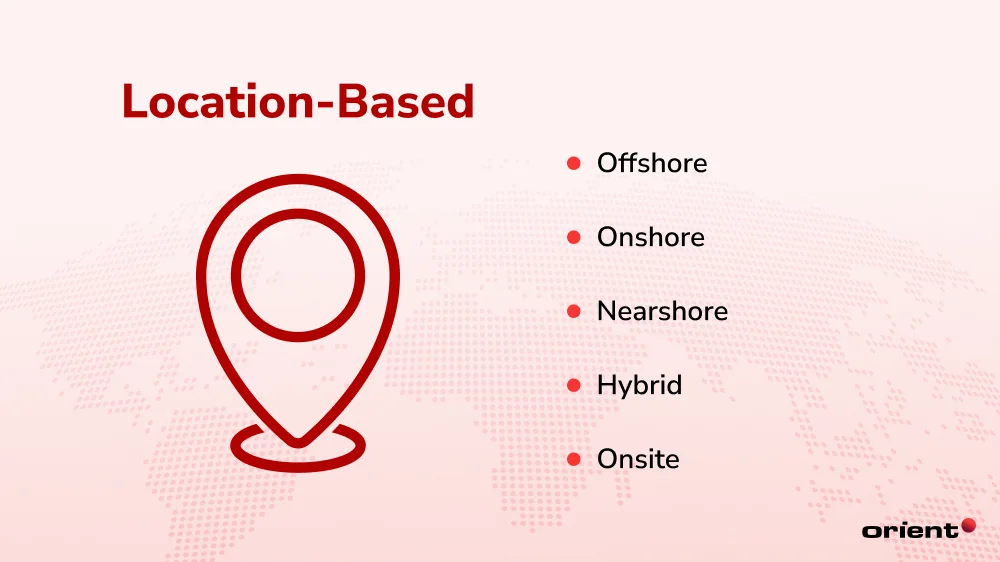
Offshore Outsourcing Model
This is when a company outsources its operations or work to an external service provider in a remote location. It is usually for the purpose of cost savings and meeting specific requirements. In most cases, companies choose this outsourcing model when there is a significant disparity in labor costs between their locations and the vendors’.
The offshore model does not favor seamless communication and collaboration due to the geographical boundaries, giving rise to some disadvantages. For example, language barriers, communication delays, cultural differences, and more. Fortunately, these are less than a problem nowadays. It is thanks to the fact that almost every outsourcing vendor delivers their services remotely with the robustness of communication tools.
Onshore Outsourcing Model
On the opposite side, outsourcing is still done but onshore instead of offshore. This model is about a company outsourcing its operations or needs to an external service provider within the same country. Onshore outsourcing comes in handy when specific requirements can only be satisfied by the home team or when your company does not wish to challenge distant collaboration.
You can benefit from the same time zone, cultural similarities, and shared language when you go with an onshore outsourcing model. However, prepare for spending more on developer salaries and other overheads that come with an onshore vendor.
Nearshore Outsourcing Model
This is similar to offshore outsourcing, but the service vendor is in a nearby country or region. The nearshore outsourcing model is beneficial because it reduces the time and costs associated with communication and travel. Also, it eases the cultural differences that may affect business dealings. Plus, business owners can maintain a level of control and oversight over their projects.
Hybrid Model
It is the best of both worlds. The hybrid setup enables you to use a blend of local and remote development teams. This outsourcing model buys you the advantages of onshore and offshore ones while minimizing the drawbacks of both.
Business owners can be creative in how they leverage various outsourcing models at their disposal to make the most out of the global talent pool. For example, you can hire an onshore team for project planning and management while having the actual work done by nearshore or offshore developers.
Onsite Outsourcing Model
In this model, the outsourced specialists are placed directly at your location to work alongside your internal team. Therefore, onsite outsourcing facilitates direct collaboration, immediate support, and a higher level of control compared to other location-based models. Nonetheless, higher costs and competitiveness for local resources hinder the scalability of this outsourcing model.
Relationship-based Outsourcing Models

Dedicated Team Model
This is one of the outsourcing models in common use. A dedicated software development team or managed team model is a form of business process outsourcing that involves hiring third-party staff to work exclusively on your development process, operation, projects, or production processes – such as design and development, software testing, etc. The staff typically works for one client and has an exclusive contractual relationship with them.
Contracting out a dedicated team means that you have an extended team working on your project without worrying about recruitment, training, or other administrative processes. Instead, they are all taken by your outsourcing vendor. There will be no long-term financial commitment associated with full-time staff. Another plus about this team composition is that you can ramp up or down at any point to fit your project requirements. Moreover, in the dedicated team model, you have full control over the team assigned to your company.
The dedicated team model is appropriate for companies that outsource an entire project or business function due to a shortage of internal resources. It’s also a good option for businesses in transition, such as overgrowing start-ups or established local companies expanding into new markets.
Staff Augmentation
Staff augmentation, also known as team extension, is also one of the prevalent models. This staffing approach enables clients like you to partner with a service provider to supplement their workforce.
In the software development industry, staff augmentation services can be used for permanent or temporary needs – such as handling a busy season, getting through a shortage of software engineers, or training current employees. This outsourcing model also brings flexibility to add more team members or to reduce the team size as needed. Business owners will have no fear of breaking the bank just for a temporary addition to their team.
The staff augmentation model typically offers a more affordable option for small businesses without the resources to attract and hire talented employees on a permanent basis.
The downside of this outsourcing model is that you often don’t have direct control over the people assigned to your project like the dedicated team model, sometimes resulting in a lack of commitment and motivation from your outsourced team members.
But good news. It will not happen if you choose a reliable partner - one with a solid track record of transparent communication, well-defined processes, and regular performance monitoring. In addition, making up your mind with clear expectations and maintaining ongoing engagement with augmented staff are the right things to do. Treat them as if they were your full-time employees to build rapport and ensure their dedication.
Project-based Outsourcing Model
Also known as a task-based model, the project-based model is one of the most common outsourcing models. It entails hiring a provider to accomplish specific tasks at an hourly rate. Once the hours are up, the contract is over unless it’s renewed by mutual agreement. For example, a company might hire a vendor to design their website and train their staff on how to update it regularly; once the design and training are complete, the contract ends unless both parties agree to extend it.
Project-based models include software development, UI/UX design, MVP development, or any type of work that can be broken down into discrete parts. This is a popular outsourcing model with small companies because it offers flexible hours and lower labor costs than other models. However, it can be risky if the service provider is incapable or unreliable.
Knowledge-based Outsourcing Models
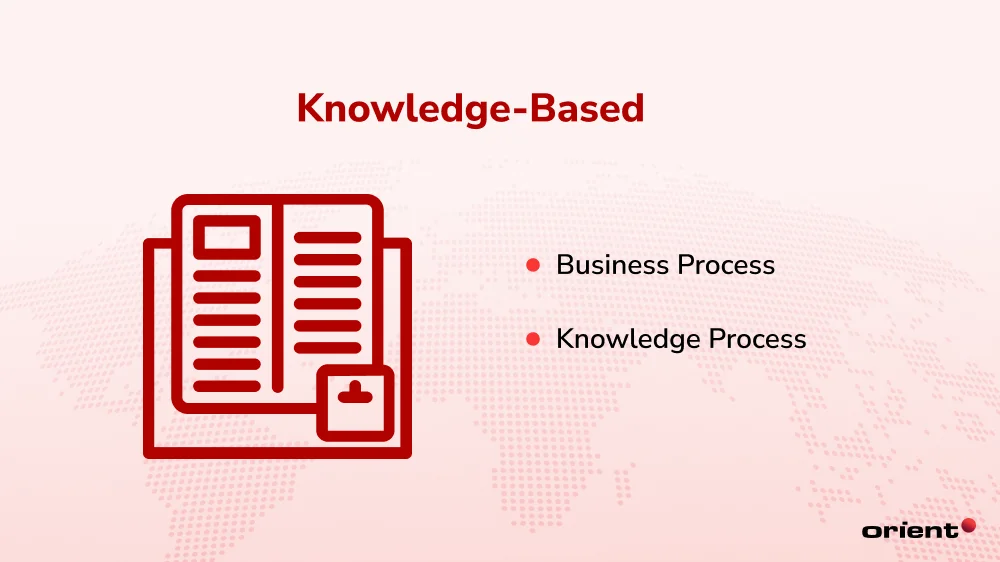
Business Process Outsourcing
BPO (or Business Process Outsourcing) is a form of outsourcing in which a company transfers tasks from internal capabilities to an external provider to boost efficiency. BPO covers a broad range of activities, including information technology, customer service, finance, human resources, and accounting. By outsourcing non-core functions, businesses can stay focused on what matters most – their core competencies. This model also offers substantial cost reduction.
Companies need to consider the challenges associated with BPO, including IT security risks due to outsourcing sensitive data, potential loss or damage of intellectual property rights, language barriers, cultural differences, and time zone issues.
Knowledge Process Outsourcing
KPO or knowledge process outsourcing is when an organization acquires the services of another company with the goal of taking advantage of that firm’s expertise. This is usually done by transferring knowledge-related tasks to an external agency, which will complete them faster and at a lower cost than in-house employees. Knowledge process outsourcing can be used for ongoing or short-term needs – such as complex projects, special studies, or one-off services.
This outsourcing model is advantageous because it allows businesses to access specialized skills or niche expertise that is often challenging to find or unavailable in house. Outsourced services are also scalable, meaning that they can expand or shrink according to your business requirements. The downside of KPO is that there may be issues communicating between multiple companies, leading to mistakes.
Knowledge process outsourcing is an excellent choice for improving efficiency or productivity without hiring additional staff. It’s also practical for businesses that lack the internal capacity to complete complex tasks.
Pricing-based Outsourcing Models
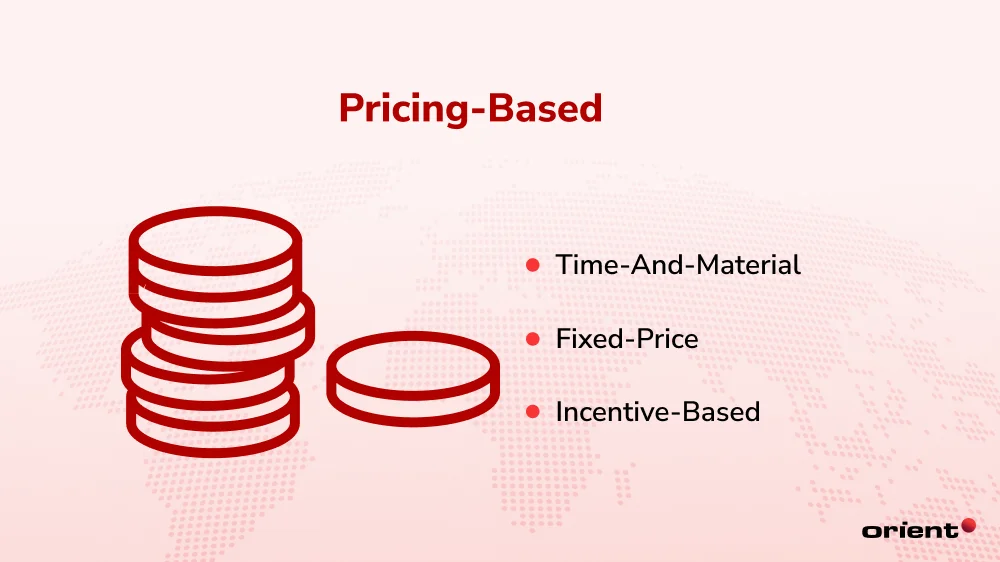
Time-and-material Model
The customers agree to pay the outsourcers a fixed monthly fee for a predetermined number of hours and/or days per month. The agreement clearly identifies the service and its scope and duration and may set out the internal processes required by the outsourcer to deliver this. A typical example is software development work, where payment is made at an hourly rate for development costs.
Fixed-price Model
In this outsourcing model, the customers pay a fixed price for a clearly defined scope of work. The model is often utilized when the clients do not want to bear any other type of risk other than budgetary risk. This is different from the time-and-material model in that no specific hours or days are specified, and there is usually a tight deadline for completion, often measured in weeks and months, not hours or days.
A typical example is a project to develop a new application. In this case, the client pays a fixed amount to the outsourcer, who agrees to develop the application within 4-6 weeks. There may also be an incentive payment if the application is completed ahead of schedule.
Incentive-based Model
This is a hybrid of the fixed-price and time-and-materials models. The client pays for results instead of working hours or materials consumed. The outsourcers will be rewarded with additional incentives if they can complete the project within budget and schedule. And, of course, there is no compromise on quality.
For that reason, the agreement also contains penalty clauses in case when milestones are not met. This pricing-based model is also known as a viable way of fostering innovation when outsourcing, as both clients and outsourcers can benefit from improvements in efficiency and cost reductions.
On-demand Outsourcing Models

Software Outsourcing
It is a general term for the process of delegating software development needs to an outside company instead of having a full-fledged in-house team provide services. This model can involve outsourcing a few business functions or the entire project. It also covers various activities, such as coding, web design, project management, QA testing, and staffing.
One tangible benefit of this outsourcing model is that it allows companies to access the talent pool and the expertise they wouldn’t otherwise gain access to due to the high costs of internal recruitment and operations. With a flexible workforce management process, you can worry less about the burden of long-term commitments or budget constraints.
Business Intelligence Outsourcing
Business Intelligence (BI) outsourcing is a business model in which a client outsources their data analytics and reporting needs to a third party. Not every organization can afford in-house BI resources; therefore, it is financially safer for you to outsource tasks on demand.
In this outsourcing model, the service vendor devises a business intelligence strategy and provides expert insights and necessary tools to implement it.
Business owners should consider this outsourcing model if they wish to enhance their analytical capabilities and empower their decision-making processes.
Managed Services
Managed services are another on-demand outsourcing model in which a customer buys a service, and the provider manages it for them, with limited or no input from the client. This is often done through a contract, in which the outsourcing partner agrees to maintain certain standards and meet specific goals. Managed services can be used for a variety of purposes, such as IT support, HR services, or marketing.
One of the key benefits is that you can save money as you only pay for the services you use and nothing more. Managed services are highly flexible and scalable, so you will deal with no trouble if your business often experiences growth or decline in workforce or demands.
This model requires minimal management and oversight from the client’s end, so they get free hands to work on other business operations. Because of that, the role of a reliable service provider is more critical. If the vendor fails to meet their commitment, the consequences quickly follow. So, be selective when choosing an outsourcing partner.
Multi-sourcing Model
As its name describes, this model involves contracting with multiple outsourcing vendors for your needs, whether they relate to software development, IT services, HR, or any other business function.
By hiring different contractors, you can leverage each other’s strengths to complement one another. This is how you break the dependency on a single vendor and mitigate the risk of service interruptions or poor quality of work. Plus, you can pick and choose which services to outsource and whom to entrust with in order to optimize your spending.
However, you will be busy dealing with many different contractors at a time. Communication and management may add more stress and complexity to your operation. Thus, prepare for it in advance if you intend to take outsourcing this way.
Consider These Factors When Selecting the Right Outsourcing Model & Vendor
As you can see, outsourcing services come in different models, each offering unique benefits for specific situations. Hence, choosing the right outsourcing model is a big decision that can make or break your endeavor and its outcome down the road. Additionally, the choice of vendor plays an equally critical role in determining your project’s success. So, consider the following factors when you consider an outsourcing model as well as a partner:
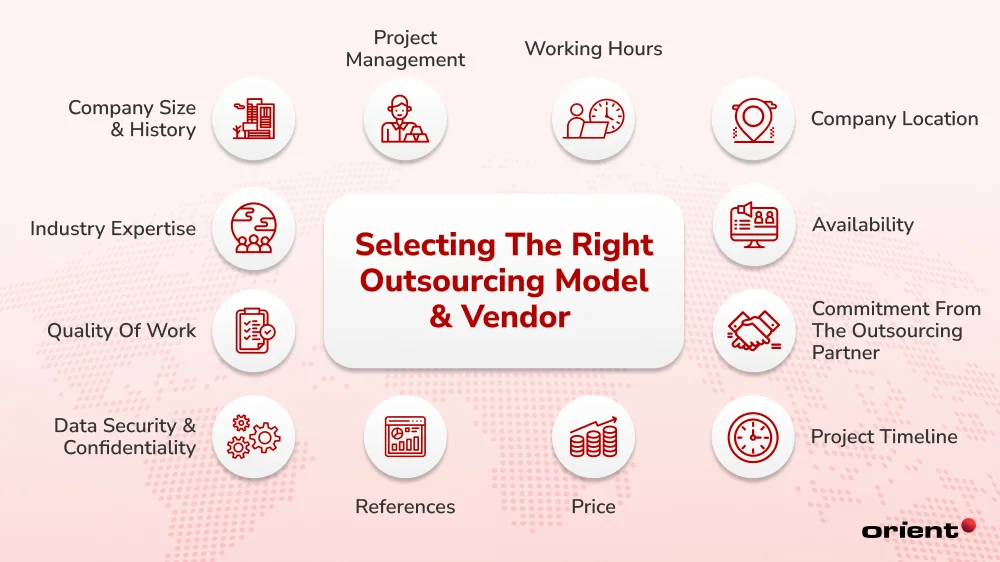
Company Size & History
You should find an outsourcing company that has been in business for several years. It reflects that the outsourcing partner is more likely to stick around until your project is finished and even beyond that.
The company should also have a solid track record and previous success stories, showing that it can produce high-quality work. An experienced vendor can guide you on the best way to handle different aspects of your project and provide valuable insights for fruitful outcomes.
Industry Expertise
Find out what the outsourcing company specializes in so that you can narrow down your search. Knowing the industry and experience of your potential outsourcing companies is essential for you to decide on the outsourcing model within their prowess and outline your expectations.
Quality of Work
Research the outsourcing company’s previous projects to see if they’re capable of completing your project with excellence. In addition, you’d better check out their portfolio and read client testimonials, as these will provide insight into the quality of their services. Finally, if you find that most agencies have worked on similar projects for other clients, you can leverage this for your own benefit.
Data Security & Confidentiality
Outsourcing might expose your company data to third-party vendors. Therefore, it is essential to guarantee that they have robust security protocols to protect confidential information from any risk or threat. A reputable outsourcing partner should be able to secure confidentiality through non-disclosure agreements (NDAs) and other security measures.
References
Contact the references provided by the company in question and ask for relevant details about their experience with them. If possible, get in touch with previous clients of the outsourcing company to gain insights into the outcomes and satisfaction level. This is how you assess a service provider in an objective manner. Hence, you can see what outsourcing models are their strengths and which are their weak points, eventually ensuring they deliver on their promises.
Price
Before agreeing on prices, you should quantify what you expect from an outsourced company so that you can gauge whether the agency’s rates meet your requirements. For instance, if you’re looking for a specialist to complete a simple business analysis study, it would be beneficial to find out how much they typically charge per hour before getting into a contract. Moreover, you should meticulously consider the pricing structure of different models and vendors to determine the one that best fits your budget.
Project Timeline
Determine if you’re looking for a short- or long-term partnership and negotiate accordingly. This will help determine how many hours and people are needed to complete your project on time and within budget.
Commitment from the Outsourcing Partner
Only work with an outsourcing agency willing to put in the time, effort, and investment to deliver quality results. At this point, you and your outsourcing partner must be on the same page. A dedicated and committed vendor can make sure they understand your requirements and work towards fulfilling them. If you are not satisfied with the vendor’s performance or the delivery, you should consider switching to another.
Availability
When checking service providers, remember to discuss how quickly outsourced staff or teams can be available at your service. For instance, if you ask for immediate support for a time-sensitive project, your prioritized choice should be the one with the shortest turnaround time.
Company Location
The factor of geographical locations is also important. If possible, find a service provide located where there is minimum delay in communication or slight time zone differences. Vietnam, for example, is one ideal destination for software development outsourcing services thanks to its tech workforce, competitive labor costs, and other advantages.
Working Hours
The outsourcing company should be able to set their business hours around your needs if an there are tasks that are carried out within a specific timeframe. Furthermore, ensure that all team members are on the same page with regards to working hours, as this will make it easier on their end to collaborate with your internal team and avoid unwanted delays.
Project Management
When outsourcing a full-fledged team or additional professionals (Augmented staff), decide whether you prefer a hands-on approach or if you would like to let the agency manage all aspects of hiring and coordinating workers for your project. This decision will impact the cost of your project and may also affect how long it takes to complete.
Frequently Asked Questions (FAQs)

How Can I Choose the Right Outsourcing Model?
The best outsourcing model is unique to each business or project, including yours. What you need is a credible outsourcing company that not only can provide solutions but also expert insights. You can consult with such a partner on which type of services and outsourcing models to opt for.
Come to Orient Software. We are a one-stop service provider for a variety of services and solutions, ranging from custom software development, web app development, mobile application development, testing, etc.
Our services are reputable for not only quality and cost-efficiency but also our level of customization. We help you navigate your choices for the most suitable model by providing an in-depth consultation session, during which our consultants assess your business requirements and goals to recommend the best course of action for each specific case. You can schedule a meeting with us easily. Drop a message here, and we will get back to you within three business days.
What Outsourcing Models Are Available at Orient Software?
When working with Orient Software, you can rest assured that there will be an outsourcing model that best suits your needs. Our offerings include all the core models mentioned above. With more flexibility, we allow our clients to shape the engagement models around their goals, project scope, budget, timeline, etc.







